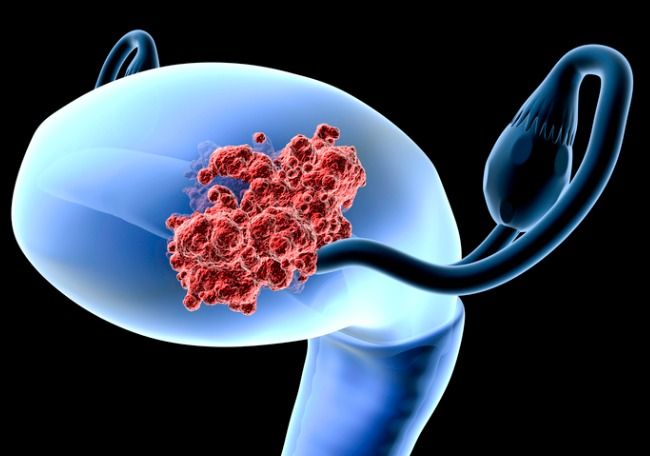Cáncer de endometrio

1. Henley SJ, Ward EM, Scott S, et al. An- nual report to the nation on the status of cancer. I. National cancer statistics. Can- cer 2020;126:2225-49.
2. Bhaskaran K, Douglas I, Forbes H, dos-Santos-Silva I, Leon DA, Smeeth L. Body-mass index and risk of 22 specific cancers: a population-based cohort study of 5·24 million UK adults. Lancet 2014; 384:755-65.
3. Cirisano FD Jr, Robboy SJ, Dodge RK, et al. Epidemiologic and surgicopatho- logic findings of papillary serous and clear cell endometrial cancers when com- pared to endometrioid carcinoma. Gyne- col Oncol 1999;74:385-94.
4. Cancer Genome Atlas Research Net- work, Kandoth C, Schultz N, et al. Integrat- ed genomic characterization of endome- trial carcinoma. Nature 2013;497:67-73.
5. Liu Y, Patel L, Mills GB, et al. Clinical
significance of CTNNB1 mutation and Wnt pathway activation in endometrioid endometrial carcinoma. J Natl Cancer Inst 2014;106(9):dju245.
6. Cherniack AD, Shen H, Walter V, et al. Integrated molecular characterization of uterine carcinosarcoma. Cancer Cell 2017; 31:411-23.
7. Lauby-Secretan B, Scoccianti C, Loomis D, Grosse Y, Bianchini F, Straif K. Body fatness and cancer — viewpoint of the IARC Working Group. N Engl J Med 2016; 375:794-8.
8. Saed L, Varse F, Baradaran HR, et al. The effect of diabetes on the risk of endo- metrial cancer: an updated a systematic review and meta-analysis. BMC Cancer 2019;19:527.
9. Barry JA, Azizia MM, Hardiman PJ. Risk of endometrial, ovarian and breast cancer in women with polycystic ovary syn-drome: a systematic review and meta-analy- sis. Hum Reprod Update 2014;20:748-58.
10. Grady D, Gebretsadik T, Kerlikowske K, Ernster V, Petitti D. Hormone replace- ment therapy and endometrial cancer risk: a meta-analysis. Obstet Gynecol 1995;85:304-13.
11. Evans AT III, Gaffey TA, Malkasian GD Jr, Annegers JF. Clinicopathologic re- view of 118 granulosa and 82 theca cell tumors. Obstet Gynecol 1980;55:231-8.
12. Bernstein L, Deapen D, Cerhan JR, et al. Tamoxifen therapy for breast cancer and endometrial cancer risk. J Natl Can- cer Inst 1999;91:1654-62.
13. Swerdlow AJ, Jones ME. Tamoxifen treatment for breast cancer and risk of endometrial cancer: a case-control study. J Natl Cancer Inst 2005;97:375-84.
14. Brinton LA, Berman ML, Mortel R, et al. Reproductive, menstrual, and medical risk factors for endometrial cancer: results from a case-control study. Am J Obstet Gynecol 1992;167:1317-25.
15. Collaborative Group on Epidemiologi- cal Studies on Endometrial Cancer. Endo- metrial cancer and oral contraceptives: an individual participant meta-analysis of 27 276 women with endometrial cancer from 36 epidemiological studies. Lancet Oncol 2015;16:1061-70.
16. Calle EE, Kaaks R. Overweight, obe- sity and cancer: epidemiological evidence and proposed mechanisms. Nat Rev Can- cer 2004;4:579-91.
17. Renehan AG, Tyson M, Egger M, Hell- er RF, Zwahlen M. Body-mass index and incidence of cancer: a systematic review and meta-analysis of prospective observa- tional studies. Lancet 2008;371:569-78.
18. Pal N, Broaddus RR, Urbauer DL, et al. Treatment of low-risk endometrial cancer and complex atypical hyperplasia with the levonorgestrel-releasing intrauterine de- vice. Obstet Gynecol 2018;131:109-16.
19. Gunderson CC, Fader AN, Carson KA, Bristow RE. Oncologic and reproductive outcomes with progestin therapy in women with endometrial hyperplasia and grade 1 adenocarcinoma: a systematic review. Gy- necol Oncol 2012;125:477-82.
20. Westin SN, Fellman B, Sun CC, et al. Prospective phase II trial of levonorg- estrel intrauterine device: nonsurgical ap- proach for complex atypical hyperplasia and early-stage endometrial cancer. Am J Obstet Gynecol 2020 August 15 (Epub ahead of print).
21. Møller P, Seppälä TT, Bernstein I, et al. Cancer risk and survival in path_MMR carriers by gene and gender up to 75 years of age: a report from the Prospective Lynch Syndrome Database. Gut 2018;67:1306-16.
22. Ryan NAJ, Morris J, Green K, et al. As- sociation of mismatch repair mutation with age at cancer onset in Lynch syndrome: im- plications for stratified surveillance strate- gies. JAMA Oncol 2017;3:1702-6.
23. Hampel H, Frankel W, Panescu J, et al. Screening for Lynch syndrome (hereditary nonpolyposis colorectal cancer) among endometrial cancer patients. Can- cer Res 2006;66:7810-7.
24. Lu KH, Schorge JO, Rodabaugh KJ, et al. Prospective determination of preva- lence of Lynch syndrome in young women with endometrial cancer. J Clin Oncol 2007;25:5158-64.
25. Schmeler KM, Lynch HT, Chen L, et al. Prophylactic surgery to reduce the risk of gynecologic cancers in the Lynch syn- drome. N Engl J Med 2006;354:261-9.
26. National Comprehensive Cancer Net- work. Uterine neoplasms, version 1. 2020 (https://www.nccn.org/professionals/ physician_gls/pdf/uterine.pdf).
27. Committee on Practice Bulletins- Gynecology, Society of Gynecologic On- cology. ACOG practice bulletin no. 147: Lynch syndrome. Obstet Gynecol 2014; 124:1042-54.
28. Cote ML, Ruterbusch JJ, Olson SH, Lu K, Ali-Fehmi R. The growing burden of endometrial cancer: a major racial dispar- ity affecting black women. Cancer Epide- miol Biomarkers Prev 2015;24:1407-15.
29. Clarke MA, Devesa SS, Harvey SV, Wentzensen N. Hysterectomy-corrected uterine corpus cancer incidence trends and differences in relative survival reveal racial disparities and rising rates of non- endometrioid cancers. J Clin Oncol 2019; 37:1895-908.
30. Doll KM, Winn AN. Assessing endo- metrial cancer risk among US women: long-term trends using hysterectomy- adjusted analysis. Am J Obstet Gynecol 2019;221(4):318.e1-318.e9.
31. Dubil EA, Tian C, Wang G, et al. Ra- cial disparities in molecular subtypes of endometrial cancer. Gynecol Oncol 2018; 149:106-16.
32. Rocconi RP, Lankes HA, Brady WE, et al. The role of racial genetic admixture with endometrial cancer outcomes: an NRG Oncology/Gynecologic Oncology Group study. Gynecol Oncol 2016;140:264-9.
33. Bregar AJ, Alejandro Rauh-Hain J, Spencer R, et al. Disparities in receipt of care for high-grade endometrial cancer: a National Cancer Data Base analysis. Gy- necol Oncol 2017;145:114-21.
34. Sud S, Holmes J, Eblan M, Chen R, Jones E. Clinical characteristics associat- ed with racial disparities in endometrial cancer outcomes: a surveillance, epidemi- ology and end results analysis. Gynecol Oncol 2018;148:349-56.
35. Mukerji B, Baptiste C, Chen L, et al. Racial disparities in young women with endometrial cancer. Gynecol Oncol 2018; 148:527-34.
36. Zaino RJ, Kurman RJ, Diana KL, Mor- row CP. The utility of the revised Interna- tional Federation of Gynecology and Ob- stetrics histologic grading of endometrial adenocarcinoma using a defined nuclear grading system: a Gynecologic Oncology Group study. Cancer 1995;75:81-6.
37. Tavassoli FA, Devilee P, eds. World Health Organization classification of tu- mours: pathology and genetics of tumours of the breast and female genital organs. Lyon, France: IARC Press, 2003.
38. Slomovitz BM, Burke TW, Eifel PJ, et al. Uterine papillary serous carcinoma (UPSC): a single institution review of 129 cases. Gynecol Oncol 2003;91:463-9.
39. Malpica A, Tornos C, Burke TW, Silva EG. Low-stage clear-cell carcinoma of the endometrium. Am J Surg Pathol 1995;19: 769-74.
40. Sreenan JJ, Hart WR. Carcinosarcomas of the female genital tract: a pathologic study of 29 metastatic tumors: further evidence for the dominant role of the epi- thelial component and the conversion theory of histogenesis. Am J Surg Pathol 1995;19:666-74.
41. Thompson L, Chang B, Barsky SH. Monoclonal origins of malignant mixed tumors (carcinosarcomas): evidence for a divergent histogenesis. Am J Surg Pathol 1996;20:277-85.
42. Costa MJ, Vogelsan J, Young LJ. p53 Gene mutation in female genital tract car- cinosarcomas (malignant mixed müllerian tumors): a clinicopathologic study of 74 cases. Mod Pathol 1994;7:619-27.
43. Abeln EC, Smit VT, Wessels JW, de Leeuw WJ, Cornelisse CJ, Fleuren GJ. Mo- lecular genetic evidence for the conver- sion hypothesis of the origin of malig- nant mixed Müllerian tumours. J Pathol 1997;183:424-31.
44. Kounelis S, Jones MW, Papadaki H, Bakker A, Swalsky P, Finkelstein SD. Car- cinosarcomas (malignant mixed mulleri- an tumors) of the female genital tract: comparative molecular analysis of epithe- lial and mesenchymal components. Hum Pathol 1998;29:82-7.
45. George E, Lillemoe TJ, Twiggs LB, Perrone T. Malignant mixed müllerian tu- mor versus high-grade endometrial carci- noma and aggressive variants of endome- trial carcinoma: a comparative analysis of survival. Int J Gynecol Pathol 1995;14:39- 44.
46. Vaidya AP, Horowitz NS, Oliva E, Halpern EF, Duska LR. Uterine malignant mixed mullerian tumors should not be included in studies of endometrial carci- noma. Gynecol Oncol 2006;103:684-7.
47. Le Gallo M, Rudd ML, Urick ME, et al. Somatic mutation profiles of clear cell en- dometrial tumors revealed by whole exome and targeted gene sequencing. Cancer 2017;123:3261-8.
Comentarios
Para ver los comentarios de sus colegas o para expresar su opinión debe ingresar con su cuenta de IntraMed.







